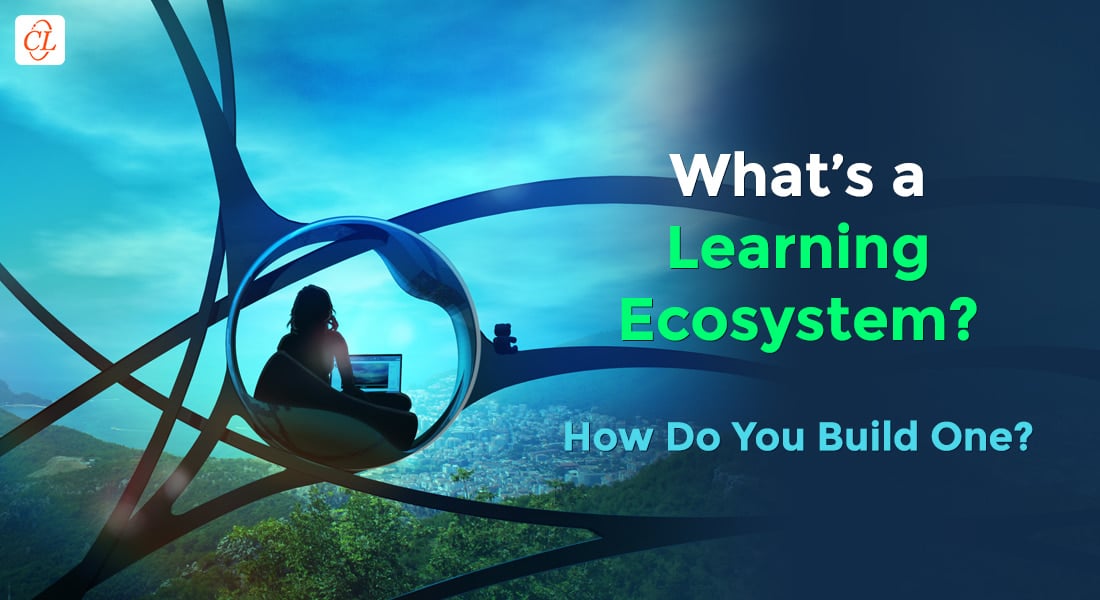An L&D Manager's Complete Guide to Setting Up an Effective Learning Ecosystem

Do you agree that when it comes to ensuring success in today’s rapidly changing business landscape, the learning ecosystem of an organization plays an important role? Yes, it certainly does! But have you ever wondered who plays an even more important role in “creating” an effective learning ecosystem? I think you guessed it right. It’s the L&D managers. They are at the forefront of this transformation where they are often tasked with cultivating an environment where learning thrives and aligns with organizational goals. However, a major question that boggles the L&D managers is, “Where to start?”. Well, if you’re an L&D manager struggling with the same or a similar situation, this comprehensive guide is for you. I'll walk you through the essentials of setting up a learning ecosystem that will help you empower your workforce and keep your company ahead of the curve. Are you ready? Let’s begin!
→ Download Now: An L&D Manager’s Guide to Successful Planning and Implementation
Table of Contents
- What is a Learning Ecosystem?
- What Are the Key Components of a Learning Ecosystem?
- Why Is an Effective Learning Ecosystem Important for Organizations?
- How Can L&D Managers Set Up an Effective Learning Ecosystem?
- What Are the Best Practices for Setting Up an Effective Learning Ecosystem?
What is a Learning Ecosystem?
A learning ecosystem is a comprehensive approach to continuous learning that goes beyond a mere collection of training programs or online courses. It is an integrated environment that enables employees to access, share, and apply knowledge seamlessly across the organization through a combination of resources, technologies, strategies, and culture.
In an effective learning ecosystem:
- Employees are active participants in their own development.
- Learning happens at all levels, both formally and informally.
- Technology and tools enhance the learning experience, making it more accessible and personalized.
What are the Key Components of a Learning Ecosystem?
A successful learning ecosystem is the outcome of various components. You need to focus on each component in order to ensure a well-designed, functional, and impactful learning ecosystem. So let’s take a look at the key components of the learning ecosystem.

People
From the employees engaging in learning to the leaders who champion it, people are the core of any learning ecosystem. Therefore, you must focus on building a learning ecosystem that supports individuals at all levels and ensuring that everyone has the opportunity to grow. Employees play an active role in the learning ecosystem by taking ownership of their development. However, in order for a learning ecosystem to flourish, it is essential that the leadership supports continuous learning.
Along with this, it is also important that the learning ecosystem includes collaboration across teams. Knowledge sharing is essential for a learning environment to thrive as it acts as a platform where everyone feels empowered to contribute to the organization’s collective success. When people are put at the center of the ecosystem, learning becomes a shared responsibility that drives both personal and organizational growth.
Content
An effective learning ecosystem requires a wide variety of learning resources, including online courses, workshops, and mentoring programs. Curating diverse, high-quality content ensures that employees have access to materials that suit their learning styles and needs.
It’s important to ensure these resources are both accessible and relevant. You can do so through online learning platforms or traditional training methods. The mix of online and offline methods, also known as blended learning, helps employees build the skills necessary to perform in their roles and grow within the organization.
Learning Culture
A strong learning culture is the heart of a successful learning ecosystem. It encourages employees to keep learning and growing by providing them with relevant opportunities. This makes the employees feel empowered to seek knowledge and improve their skills.
For an effective learning ecosystem, it is important that the learning culture is established on the idea that learning is not just a one-time event but an ongoing process. With that said, it must be supported by the organization's leaders. So focus on cultivating a safe environment where employees can share ideas freely, learn new information and concepts, practice new skills, and are not afraid to commit mistakes and learn from them.
Learning Strategy
The learning strategy aligns your organization’s learning efforts with its broader goals. It serves as the roadmap that guides the development, implementation, and measurement of learning initiatives. By identifying key learning needs and priorities, you can ensure that learning programs support both individual development and the company’s strategic objectives. A well-crafted strategy for an effective learning ecosystem outlines a comprehensive plan that includes various learning methods and measurable outcomes, driving long-term success.
Technology
Technology plays a key role in modern learning ecosystems. Choosing the right tools and platforms significantly contributes to enhancing the learning experience. It does so by making the training content easily accessible, trackable, and interactive. Furthermore, effective integration of technology with existing systems ensures smooth functionality and allows for more personalized learning experiences.

An L&D Manager's Guide to Successful Planning & Implementation.
Discover Foolproof Planning and Implementation Ways for Impactful L&D Solutions
- Challenges for L&D Managers
- Strategy and Planning to Achieve Business Goals
- Designing Specific Roadmaps/Learning Journeys
- Implementation and Impact of Learning Solutions
Why Is an Effective Learning Ecosystem Important for Organizations?
In a world of constant change, adaptability is key. A strong learning ecosystem gives your employees the skills and knowledge they need to stay ahead of industry trends, meet business challenges head-on, and innovate.
But the reasons don’t end there.

Let’s take a detailed look at some of the other noteworthy advantages of fostering an effective learning ecosystem in your organization:
Boosts Employee Engagement
When learning becomes an integral part of your company culture, it promotes employee engagement as the employees naturally feel more connected to their roles, the organization, and their own professional development. Wondering how? Well, here’s the answer.

Now let’s take a closer look at each aspect.
Empowerment and Ownership: When you offer various learning opportunities, such as workshops, eLearning modules, and peer-to-peer sessions, employees have the freedom to choose their own learning paths. This autonomy gives them a sense of control over their careers and encourages them to take ownership of their learning journeys, thereby increasing motivation and engagement.
Personal and Professional Growth: Employees are more likely to engage when they see opportunities to grow, both personally and professionally. By embedding learning into everyday work life, you create a culture that values and prioritizes employee development. This leads to a sense of accomplishment, purpose, and satisfaction, as individuals feel their skills are evolving and that they are becoming better at their jobs.
Recognition and Reward: A learning-centric culture often includes systems that recognize and reward those who actively engage in learning. Whether through certifications, badges, promotions, or even informal recognition, these rewards reinforce positive learning behaviors and make employees feel valued, which directly boosts engagement.
Foster Collaboration: A learning ecosystem encourages knowledge-sharing and promotes stronger relationships between teams. When employees share insights, collaborate on learning initiatives, and mentor each other, it builds a more inclusive and supportive work environment, enhancing engagement across all levels of the organization.
Promotes Agility
In today’s fast-paced and constantly changing business environment, agility is essential for survival and success. An effective learning ecosystem provides the necessary tools and resources to foster organizational agility in different ways. Check out the mini infographic below for an overview.

Now let’s zoom in to understand each aspect in detail.
Rapid Skill Development: As industries evolve, so do the skills required to stay competitive. An effective, dynamic learning ecosystem allows employees to quickly access the resources they need to learn new skills or update existing ones. This continuous learning enables the workforce to stay adaptable and ready to meet new challenges. These challenges can range from technological advancements to market shifts to changes in customer demands.
Flexible Learning Methods: An effective learning ecosystem offers flexibility in how learning is delivered. Depending on their needs and preferences, employees can engage in microlearning modules, virtual training (VILT), eLearning, hands-on workshops, etc. This flexibility ensures that learning doesn’t disrupt work but instead fits seamlessly into employees’ schedules, allowing them to be agile learners who can adapt to different situations as and when needed.
Quick Response to Change: An organization can experience various changes like implementing new software, shifting company strategies, or complying with regulatory updates. In times like these, a well-planned learning ecosystem comes in handy. It equips employees with just-in-time training. This allows them to learn on the go and quickly adapt to new tools or processes without significant downtime. As a result, the organization as a whole becomes more resilient and better positioned to tackle emerging challenges or capitalize on new opportunities.
Cross-Functional Learning: An effective learning ecosystem promotes agility not only at the individual level but across the organization. Employees from different departments can collaborate and share knowledge. It helps in breaking down silos and promoting a culture where cross-functional learning happens organically. This cross-pollination of ideas and skills makes it easier for teams to respond collectively and efficiently to changes.
Supports Long-Term Growth
A sustainable learning ecosystem is a strategic asset for long-term organizational success. Let’s see how.

Here’s the explanation.
Builds a Future-Ready Workforce: A strong learning culture ensures that employees are continually developing the skills they need not only for their current roles but also for future opportunities. This focus on upskilling and reskilling prepares your workforce for future challenges and innovations. It also positions the organization for long-term success in a competitive environment.
Attracts and Retains Top Talent: It’s no surprise that talented individuals are drawn to organizations that invest in their professional development. A well-structured learning ecosystem demonstrates that your company values growth, not just in terms of business objectives but also for the individual careers of employees. When employees see that their growth is a priority for the organization, they are more likely to stay with the organization. It reduces turnover and promotes employee retention, ensuring that the institutional knowledge is retained.
Sustains Innovation: Continuous learning fosters a culture of innovation. Employees who are encouraged to learn, experiment, and share new ideas contribute to a workplace that’s always evolving. This innovation is critical for long-term growth, as it ensures that the organization remains adaptable and forward-thinking, rather than resting on past successes.
Alignment with Business Strategy: As the organization’s goals evolve, so must its learning strategy. A learning ecosystem aligned with business objectives ensures that employees are gaining skills and knowledge that directly contribute to the company’s long-term growth. Whether it’s expanding into new markets, adopting cutting-edge technology, or developing new products, a progressive learning ecosystem ensures that the workforce is always equipped to support and drive these goals forward.

An L&D Manager's Guide to Successful Planning & Implementation.
Discover Foolproof Planning and Implementation Ways for Impactful L&D Solutions
- Challenges for L&D Managers
- Strategy and Planning to Achieve Business Goals
- Designing Specific Roadmaps/Learning Journeys
- Implementation and Impact of Learning Solutions
How Can L&D Managers Set Up an Effective Learning Ecosystem?
As an L&D manager, your role in setting up a learning ecosystem goes beyond simply offering training. You are a strategist, a facilitator, and a change agent. So here are the steps you need to follow to ensure a productive, effective learning ecosystem.
Wish to Set Up an Effective Learning Ecosystem?
Here’s how to do it:
- Identify Learning Needs and Skill Gaps
- Develop a Learning Strategy
- Create and Curate Learning Resources
- Leverage the Right Learning Technologies
- Measure Effectiveness
- Modify the Training Content
Identify Learning Needs and Skill Gaps
The foundation of an effective learning ecosystem begins with a clear understanding of your organization’s specific learning needs. Start by conducting a training needs analysis (TNA) to identify the areas where your employees need to work the most. This can be done through surveys, performance reviews, discussions, questionnaires, collaboration with department heads, etc.
Additionally, consider the long-term goals of the organization and align learning initiatives with these business objectives. By understanding what skills are needed now and in the future, you can design a more targeted and impactful learning ecosystem.
Develop a Learning Strategy
Once you have identified the learning needs, it’s time to develop a learning strategy. Your strategy should outline how learning initiatives will align with organizational goals and employee growth. For this, work closely with leadership to ensure that learning programs are tied to strategic priorities.
For instance, if the company plans to innovate through new technology, your learning strategy should focus on building technical skills across the workforce. The strategy should also address various learning methods, ensuring there is a balance between formal, informal, and experiential learning opportunities.
Create and Curate Learning Resources
Once the learning needs are identified and the learning strategy is in place, the next step is curating learning resources. Creating an effective learning ecosystem stays as far as possible from following the one-size-fits-all approach. Instead, it focuses on thoughtful selection and integration of various types of learning content and formats in order to cater to different types of learners.

Coming to the different types of learning formats that you can include in the learning ecosystem, can be formal eLearning courses, simulations, eLearning interactivities, scenario-based learning, microlearning courses, etc. And the content can range from specific topics like sales techniques, objection handling, etc., to more general topics like mentorship programs, soft skills training, etc.
Therefore, you should make sure that your learning ecosystem is diverse in its offerings and caters to different learning styles and needs. It should also provide a balance between self-paced learning and collaborative, social learning experiences.
Here’s an infographic to help you leverage social learning in an impactful way and make the most of it.

Leverage the Right Learning Technologies
Technology is a critical enabler in any learning ecosystem. Choose the right learning management system (LMS) and other learning tools that can support your strategy and provide a seamless experience for learners.
Watch this video to learn how you can select the right LMS for your needs.
In a nutshell, your LMS should integrate easily with other systems, such as HR and performance management platforms, allowing you to track and analyze learning outcomes.
Additionally, consider using technologies like AI-enabled eLearning authoring tools and AI tools for videos, image generation, etc.
Some of the popular examples of AI tools you can use in your eLearning design and development process are:
- ChatGPT
- Midjourney
- Vyond Go
- Synthesia
You can also invest in tools and technology that support personalized learning paths, gamification, simulations, etc., to make learning more engaging. Customization enhances the learning experience, making it more engaging and relevant. Employees are more likely to remain motivated when they see that their development aligns with their personal and professional aspirations. By prioritizing personalized learning, you also boost retention and ensure that the learning ecosystem is adaptable to the evolving needs of your workforce.
Virtual learning environments and mobile learning platforms can also help make learning more flexible and accessible to employees at any time, from anywhere.
Measure Effectiveness
To ensure that your learning ecosystem is delivering results, it’s essential to track and measure its effectiveness. Use data to assess key metrics, such as participation rates, completion rates, learner engagement, assessment scores, improvement in performance and productivity, etc.
You can also use feedback from employees to identify areas of improvement. Implement evaluation methods like post-training surveys, eLearning assessments, and ROI analysis to gauge the success of learning initiatives. Here’s an infographic to help you solicit feedback in the right way.
Modify the Training Content
It is key to ensuring that your learning ecosystem evolves and improves over time. Using the learning analytics garnered in the previous step, you must refine your learning strategies, training content, and training formats. Utilizing the insights gathered, it's important to keep the learning ecosystem dynamic, relevant, and in tune with both business objectives and employee ambitions. Clearly, your position is crucial to the effectiveness of a successful learning ecosystem and essential for the organization in achieving both short-term learning results and long-term development.
What Are the Best Practices for Setting Up an Effective Learning Ecosystem?
Setting up a learning ecosystem is an ongoing process. Here are some best practices to keep in mind:
Involve Stakeholders
Involving stakeholders in the process of setting up a learning ecosystem is crucial to its success. Stakeholders such as employees, managers, and other relevant parties have valuable insights that can guide the design and implementation of the ecosystem. Employees can share what skills they feel they need, while managers can provide a broader view of what the organization requires to meet its objectives.
By actively seeking input from these groups, you ensure that the learning ecosystem addresses the real needs of your workforce and aligns with business goals. Additionally, involving stakeholders fosters a sense of ownership, making them more likely to support and engage with the learning ecosystem once it’s in place. This approach leads to a more tailored, relevant, and effective learning ecosystem that delivers results for both individuals and the organization.
Maintain a Balance Between Self-Paced Learning and Collaboration
While collaboration is the cornerstone of a thriving learning ecosystem, self-paced learning is equally important. Provide opportunities for employees to learn at their own pace through online courses, microlearning, and other self-directed resources. At the same time, create avenues for collaborative learning, such as team projects, peer-to-peer learning, and group discussions. By striking the right balance, you can cater to different learning preferences and foster a culture of continuous growth and knowledge sharing.

An L&D Manager's Guide to Successful Planning & Implementation.
Discover Foolproof Planning and Implementation Ways for Impactful L&D Solutions
- Challenges for L&D Managers
- Strategy and Planning to Achieve Business Goals
- Designing Specific Roadmaps/Learning Journeys
- Implementation and Impact of Learning Solutions
Incorporate Adult Learning Principles
Adult learners come with unique needs and expectations, and an effective learning ecosystem incorporates key adult learning principles to ensure the content resonates with and engages employees. Adults are more self-directed, prefer learning that is relevant to their work, and are motivated by the need to solve real-world problems. To support this, ensure that learning programs are practical and immediately applicable, offering employees the opportunity to apply their new skills in their day-to-day tasks.
Encouraging active participation and collaboration helps adult learners take ownership of their development. By providing opportunities for employees to reflect on their experiences, share insights, and collaborate on problem-solving, you create a learning environment that is not only informative but also empowering. Moreover, offering employees choices in how and what they learn—whether through formal training, mentoring, or informal knowledge sharing—reinforces autonomy and aligns learning with individual career aspirations.
Keep it Engaging
Learner engagement plays a vital role in the success of a learning ecosystem. If learning isn’t interesting or rewarding, employees are less likely to participate actively or retain the information they receive. Keeping learning engaging can involve a mix of interactive and multimedia components. They capture employees’ attention and maintain their interest throughout the learning process by offering opportunities to interact with the training content.
Some of the impactful instructional design strategies to keep the learning process engaging include gamification, simulation, storytelling, and scenario-based learning. Gamification, for example, can turn learning into a fun and rewarding experience by incorporating elements like leaderboards, badges, and challenges that motivate employees to reach their learning goals. Scenario-based learning and simulations on the other hand engage employees through immersive experiences that allow them to practice applying their knowledge in real-world situations.
Prioritize Personalization
One size does not fit all when it comes to learning. Personalization is a best practice that ensures that learning experiences are tailored to the unique needs, preferences, and career aspirations of each employee. By leveraging technology like artificial intelligence (AI) and machine learning, you can offer personalized learning pathways that cater to individual skill gaps, interests, and goals. These tools can analyze employee performance, learning habits, and preferences to recommend courses, articles, and development programs that are most relevant to each learner.
Here’s a mini infographic to give you an idea about the benefits of personalized learning.

Assess and Improve Your Learning Ecosystem Regularly
A successful learning ecosystem is never static—it requires continuous evaluation and iteration. To ensure that your learning ecosystem remains effective and aligned with business goals, you must regularly assess its performance using both qualitative and quantitative data. Using this information, you can pinpoint areas that need enhancement and implement changes to optimize the ecosystem. This iterative approach allows you to stay agile and responsive to changing organizational needs, employee expectations, and technological advancements. By continuously measuring and refining the learning ecosystem, you ensure its long-term sustainability and effectiveness.
Foster a Learning Culture
An effective learning ecosystem thrives on a culture of continuous learning. As an L&D leader, it's important that you promote a learning culture where employees feel motivated and supported to develop their skills. You can do so by facilitating an environment where learning is celebrated, sharing knowledge is valued, and mistakes are seen as growth opportunities.
The leadership in your organization must model this behavior by prioritizing their own learning and supporting their teams in pursuing development opportunities. A culture that embraces learning as an essential part of work will naturally lead to higher employee engagement and better learning outcomes.
Wrapping It Up!
Building a learning ecosystem is no small task, but with the right strategy, tools, and culture in place, you can create a thriving environment that supports continuous learning and drives business success. Remember, the ecosystem you build today will be the foundation for your company’s future growth. Take the time to invest in it, and watch your employees and organization flourish. If you wish to foolproof the planning and implementation of your L&D solutions, then here’s an eBook you can’t miss. Download it now!






